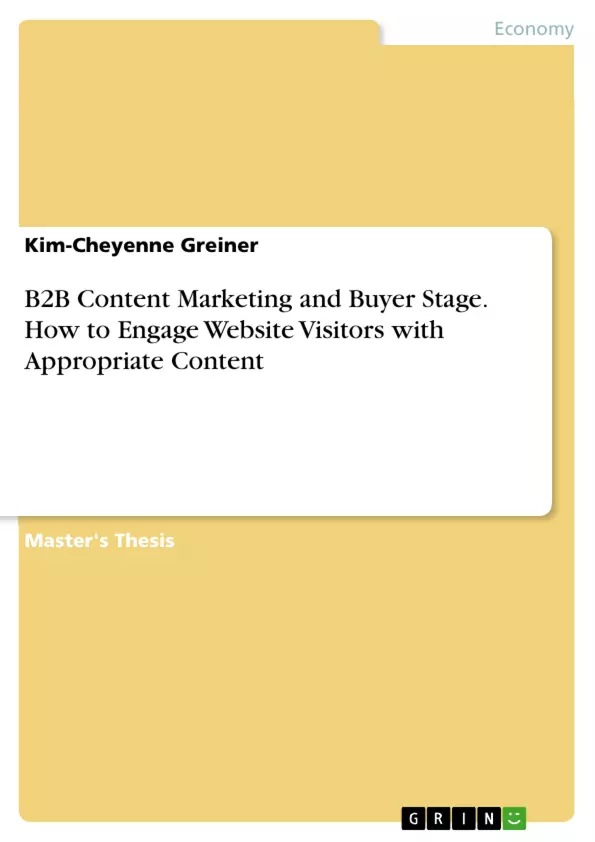This Master's thesis explores whether there are content stimuli that are best suited to a specific stage of the customers' buying cycle. In other words, is there a connection between the engagement of website visitors and their current stage within the buying cycle? To study this relationship, an external webpage of IBM and its sub-pages are used to analyze webpage visitors' click and scroll behavior and to assess their interest in the presented content assets. The exploratory investigation was undertaken based on three online surveys with a total sample of 234 participants.
The age of classical advertising is over. The introduction of digital technology and the spread of the Internet have led to radical changes in the way companies meet the expectations and interests of their stakeholders. In digital communication, content marketing plays a major role in achieving business benefits. In fact, valuable B2B content marketing initiatives can drive website traffic, customer engagement, and inbound leads, which yield sales and retain customers. In the context of this digital environment, companies increasingly aim to provide relevant, engaging content assets to acquire new leads and create business benefits.
This raises the following question: What digital content assets encourage website visitor engagement and how does this relate to customer progress in the B2B buying cycle? According to the literature, content that is consistent, timely and contains exclusivity messages that matter to the target audience lead to engagement. However, engagement is obviously dependent on individual customer needs, motives, and goals. It should, therefore, be interesting for companies to know how to turn their website visits into engaged visits, but research on engagement combined with content marketing is scarce—especially in the B2B context.
Inhaltsverzeichnis (Table of Contents)
- 1 Introduction
- 1.1 Initial Situation
- 1.2 Research Question and Objectives
- 1.3 Structure
- 2 Fundamentals
- 2.1 B2B Buying Process
- 2.1.1 Customer Journey
- 2.1.2 How to Acquire Leads: The Sales Funnel
- 2.1.3 Hierarchy-of-Evidence
- 2.2 Content Marketing and Engagement
- 2.2.1 Content Assets to Engage Customers
- 2.2.2 Content KPIs
- 2.2.3 Hierarchy-of-Evidence
- 3 Hypotheses
- 3.1 Website Visitors’ Engagement
- 3.1.1 Customer Engagement and Buying Stage
- 3.1.2 Customer Engagement and Involvement
- 3.1.3 Customer Expectation Fulfillment and Buying Stage
- 3.2 Website Design
- 3.2.1 Heat Mapping
- 3.2.2 Content Asset Preferences
- 3.3 Overview of the Hypotheses
- 4 Methodology
- 4.1 Surveys
- 4.1.1 Sample
- 4.1.2 Design, Instrumentation and Procedure
- 4.1.3 Measures
- 4.1.4 Pre-Test
- 4.1.5 Data Analysis
- 4.2 Website Analysis
- 4.2.1 Heat Mapping
- 4.2.2 Content Assets
- 5 Results and Discussion
- 5.1 Results of H1
- 5.2 Results of H2
- 5.3 Summary of Results
- 5.4 Quality Criteria
- 5.5 Managerial Implications and Discussion
- 6 Limitations and Further Research
- 6.1 Strengths and Limitations
- 6.2 Implications for Future Research
- 6.3 Concluding Remarks
Zielsetzung und Themenschwerpunkte (Objectives and Key Themes)
This Master's thesis investigates the relationship between B2B content marketing, website visitor engagement, and the buyer stage within the customer journey. It aims to identify content stimuli that best engage potential buyers at different stages of their buying cycle. The study uses an IBM website as a case study to analyze visitor click and scroll behavior.
- The impact of content marketing on B2B website engagement.
- The correlation between visitor engagement and their stage in the buying cycle.
- The influence of visitor profiles and IT involvement on engagement.
- The effectiveness of different content assets (e.g., demos, white papers) in driving engagement.
- Optimizing website design for enhanced user experience and engagement.
Zusammenfassung der Kapitel (Chapter Summaries)
Chapter 1: Introduction Introduces the context of content marketing in a digital B2B environment, highlighting the shift from traditional advertising and the importance of engaging website visitors. It defines the research question and objectives, outlining the structure of the thesis.
Chapter 2: Fundamentals Defines key terms (B2B buying process, content marketing, engagement) and presents relevant theories. It explores the B2B buying process, including the customer journey and sales funnel models, emphasizing the importance of understanding customer behavior at various stages.
Chapter 3: Hypotheses Develops hypotheses based on the literature review to explore the relationships between visitor engagement, buyer stage, visitor profiles, IT involvement, and website design. It outlines the specific hypotheses to be tested in the empirical study.
Chapter 4: Methodology Describes the methodology used to test the hypotheses, including the design and implementation of three online surveys and the use of the Hotjar heat-mapping program for website analysis. It details the data collection process, sample characteristics, and statistical methods employed.
Chapter 5: Results and Discussion (Partial) Presents the results of the statistical analyses, focusing on the correlations between visitor engagement and their buying stage, involvement, and the effectiveness of different website design elements and content assets. It includes interpretations of the findings from the Hotjar analysis, without revealing major conclusions.
Schlüsselwörter (Keywords)
Content Marketing, Website Engagement, Customer Journey, B2B Buying Process, Heat Mapping, Content Assets, Lead Generation, IBM, Digital Business Automation.
- Quote paper
- Kim-Cheyenne Greiner (Author), 2018, B2B Content Marketing and Buyer Stage. How to Engage Website Visitors with Appropriate Content, Munich, GRIN Verlag, https://www.grin.com/document/944693



